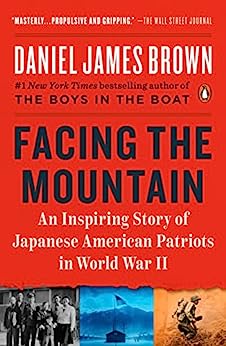Facing the Mountain: An Inspiring Story of Japanese American Patriots in World War II by Daniel James Brown is an enthralling in-depth chronicle of war-time America and the valor of Japanese Americans in battlefields across Europe.
Facing the Mountain tells the story of Japanese Americans, both first-generation and their children, and the important part they played in World War II. The story follows four young Japanese men and their parents before, during, and after the war years.
Since Japan’s attack on Pearl Harbor on December 7, 1941, Japanese Americans in Hawaii and the American mainland had been persecuted: Buddhist temples ordered closed, Japanese-language school and community Japanese newspapers shut down, bank accounts frozen, fishermen banned from fishing, children barred from parks, turned away at theaters, shops refused service, long-time employees fired, business licenses rescinded.
Almost all Issei—first-generation Japanese men—were forced from their homes, taken without charges, with no spare clothes, without explanations of where they were going. Offspring of Issei, called Nisei, were shunned. Nearly three-fourths of the Hawaii Territorial Guard were Japanese and they were immediately dismissed because of their race. The boys were stunned, heart-broken that they were not trusted, not seen as American.
Japanese Americans in Hawaii and mainland America were rounded up with little notice, given orders to take only what they could carry, and were placed in internment camps. More than 100,000 people lived behind barbed wire in America in crowded, noisy, unsanitary conditions. Many of the camps had scant bathroom facilities–in some cases only a bucket for a toilet. Yet the detainees made do and constantly strove to make improvements.
In December, 1941, America entered World War II in Europe against Germany’s aggression toward Italy and France. Men were being drafted into the Army by the thousands. The army called for fifteen hundred Nisei volunteers from Hawaii. Nearly ten thousand turned out. The young men who served in the U.S. Army’s 442nd Regimental Combat Team were later recognized for their valor in battle. Composed of soldiers of Japanese ancestry, the 442nd became one of the most decorated military units in U.S. history.
I lived and worked in Hawaii from 1955 to 1957. Honolulu Savings & Loan employed about 25 people comprised of six Haoles (white people) one Chinese and the rest Japanese. On Pearl Harbor Remembrance Day, December 7, 1955, I dreaded going to work, thinking it was going to be a day filled with tension, maybe even bitterness. But I found the Japanese I worked with to be very forth-coming with their stories, told without bitterness or rancor. Some talked about their fathers being torn away from their families; some of the men had served in the military. One of the men served as interpreter on a U.S. Navy ship, the only Japanese aboard. I asked what that was like. “Very lonely, no one trusted me.” But he said it with a smile and with no judgement toward me. It was a day I’ll never forget.
As I read Facing the Mountain, I was again impressed with Japanese American involvement in World War II, their bravery and dedication to America’s commitment to freedom. It is a well-documented book, told with openness and honesty. I highly recommend it.


